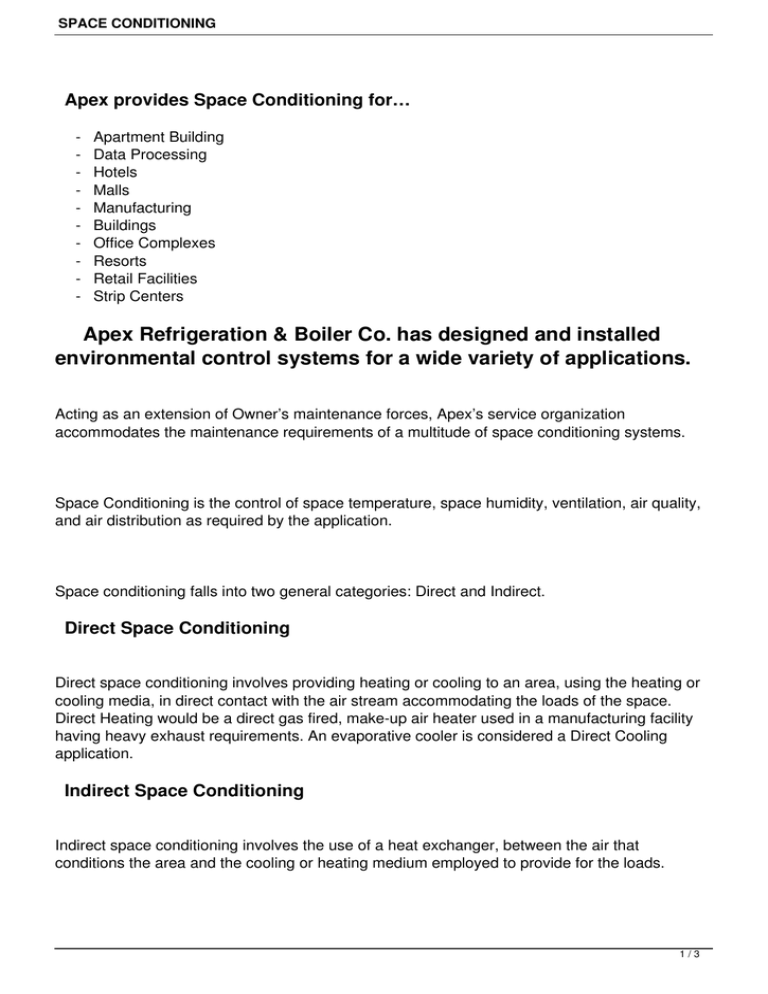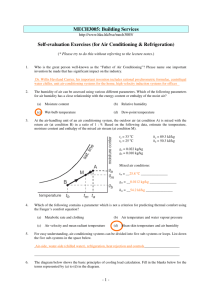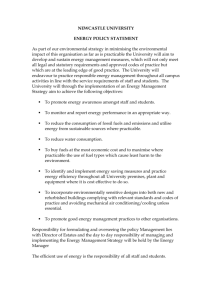space conditioning - Apex Refrigeration
advertisement

SPACE CONDITIONING Apex provides Space Conditioning for… - Apartment Building Data Processing Hotels Malls Manufacturing Buildings Office Complexes Resorts Retail Facilities Strip Centers Apex Refrigeration & Boiler Co. has designed and installed environmental control systems for a wide variety of applications. Acting as an extension of Owner’s maintenance forces, Apex’s service organization accommodates the maintenance requirements of a multitude of space conditioning systems. Space Conditioning is the control of space temperature, space humidity, ventilation, air quality, and air distribution as required by the application. Space conditioning falls into two general categories: Direct and Indirect. Direct Space Conditioning Direct space conditioning involves providing heating or cooling to an area, using the heating or cooling media, in direct contact with the air stream accommodating the loads of the space. Direct Heating would be a direct gas fired, make-up air heater used in a manufacturing facility having heavy exhaust requirements. An evaporative cooler is considered a Direct Cooling application. Indirect Space Conditioning Indirect space conditioning involves the use of a heat exchanger, between the air that conditions the area and the cooling or heating medium employed to provide for the loads. 1/3 SPACE CONDITIONING When the heat exchanger uses evaporating refrigerant for cooling or burns natural gas for heating, it is considered a “primary indirect system.” If the heat exchanger employs a secondary heat transfer fluid, such as chilled water or glycol for cooling and/or hot water or steam for heating, it is considered a “secondary indirect system.” Primary Indirect Systems Primary indirect systems are cooling systems which may be as simple as packaged roof-top equipment serving strip centers, or as extensive as a manufacturing facility having multiple remote evaporators served from a central engine room. Primary indirect systems spot heating for manufacturing facilities, garages, and outdoor locations. Snow melting may be provided by radiant heating systems, employing the combustion of natural gas within a heat exchanger at high enough temperatures to provide heat via radiant effect. Advantages of Primary Indirect systems are: well suited for small applications, low initial equipment cost, rapid installation time, minimal ductwork and redundancy of equipment. Disadvantages of Primary Indirect system for large applications are: impractical equipment placement standpoint, increased initial electrical distribution costs, possible increased maintenance cost of multiple units, and possible increased operating cost due to multiple units being required to operate for partial loads. Secondary Indirect Systems Secondary indirect systems usually have a boiler and chiller located in a central equipment room, with cooling and heating medium piped to heat exchange coils in terminal units located throughout the facility. Secondary indirect systems usually employ multiple air handlers within or adjacent to the space, or perhaps “multi-zone systems” to provide for multiple zones of temperature control. In the case of hotels, offices, and apartment buildings, “terminal units” are often used for individual space temperature control. The ultimate in user satisfaction is obtained from those systems which allow heating or cooling to be available from all units at any time of the year. 2/3 SPACE CONDITIONING Secondary indirect space conditioning may also be accomplished by radiant ceiling panels, which function as a finished ceiling as well as a means of space conditioning. These panels operate at relatively low heating temperatures, and relatively high cooling temperatures, and substantially minimize air distribution requirements, with accompanying reductions in ductwork and fan horsepower. Air Quality Air quality is determined by fresh air quality and quantity, and the source of air contaminates. Air quality is always a concern; it is important to analyze the sources of contamination, and design a system to provide the desired end results. Humidity Control For most comfort applications, proper selection of equipment will provide for humidity maximums in the range of 45 to 55% during the summer months, with little thought being given to low winter humidity being a problem. Humidity control within specific ranges, for those applications requiring such, may be attained through various means such as water vaporization, reheat, or steam injection. Occupant discomfort, product needs, static electricity, or other requirements may demand precise humidity control. Thermal Storage Indirect applications lend themselves to utilization of Thermal Storage concepts. Dependant on cooling load, occupied hours, and utility rate schedules, it may be possible to generate cooling effect at minimum power rates, store this effect, and reduce operating costs. There are examples of primary indirect systems being converted to secondary indirect systems with thermal storage, and substantially reducing operating and maintenance costs. Apex Refrigeration & Boiler Co.’s experience with heating and cooling equipment and systems provided for owners’ single source of responsibility for their space conditioning requirements, is in an excellent position to accommodate the requirements of all Space Conditioning applications. 3/3

